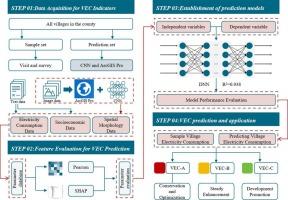基于CNN-DNN框架整合建设用地形态的村庄用电量预测——以285个寒区村庄为例
IF 7.1
2区 工程技术
Q1 CONSTRUCTION & BUILDING TECHNOLOGY
引用次数: 0
摘要
随着中国乡村振兴战略的深入实施,村庄用电量预测已成为能源规划的重要组成部分。然而,传统方法面临着数据采集困难、预测速度慢等挑战。本研究以建设用地为研究对象,开发了一种整合形态和社会经济数据的深度学习框架,用于VEC预测。以中国寒冷地区285个村庄为研究对象,构建了CNN-DNN双模型框架:CNN自动提取高分辨率卫星影像中的9个形态参数,结合3个社会经济数据构建特征集,DNN实现VEC预测。该方法既避免了传统野外调查的时间和成本限制,又解决了农村地区的数据采集难题,使大规模VEC评估成为可能。SHAP分析表明,居住用地面积(RLA)和常住人口(PP)是主要预测因子,呈现非线性阈值效应。模型表现优异(R2 = 0.938, RMSE = 815,821 kWh),识别出高消费村(15%)、中等消费村(64%)和低消费村(21%)三种VEC模式,呈现出显著的空间分异特征。该框架为快速评估VEC和制定中国寒区差别化电力政策提供了科学的工具和方法。本文章由计算机程序翻译,如有差异,请以英文原文为准。

Village electricity consumption prediction using CNN-DNN framework integrating construction land morphology: A Case study of 285 villages in cold regions
With the deepening implementation of China’s rural revitalization strategy, village electricity consumption (VEC) prediction has become a crucial component of energy planning. However, traditional methods face challenges including data acquisition difficulties and slow prediction speeds. This study focuses on construction land and develops a deep learning framework integrating morphology and socioeconomic data for VEC prediction. Using 285 villages in cold regions of China as research subjects, a CNN-DNN dual-model framework was developed: CNN automatically extracts nine morphology parameters from high-resolution satellite imagery, combines with three socioeconomic data to construct feature sets, and DNN realizes VEC prediction. This method not only avoids the time and cost limitations of traditional field surveys, but also solves the data acquisition challenges in rural areas, making large-scale VEC assessment possible. SHAP analysis reveals that residential land area (RLA) and permanent population (PP) are the dominant predictive factors, exhibiting nonlinear threshold effects. The model demonstrates excellent performance (R2 = 0.938, RMSE = 815,821 kWh), identifying three types of VEC patterns: high-consumption villages (15 %), medium-consumption villages (64 %), and low-consumption villages (21 %), showing significant spatial differentiation characteristics. This framework provides scientific tools and methods for rapid assessment of VEC and formulation of differentiated electricity policies in cold regions of China.
求助全文
通过发布文献求助,成功后即可免费获取论文全文。
去求助
来源期刊

Energy and Buildings
工程技术-工程:土木
CiteScore
12.70
自引率
11.90%
发文量
863
审稿时长
38 days
期刊介绍:
An international journal devoted to investigations of energy use and efficiency in buildings
Energy and Buildings is an international journal publishing articles with explicit links to energy use in buildings. The aim is to present new research results, and new proven practice aimed at reducing the energy needs of a building and improving indoor environment quality.
 求助内容:
求助内容: 应助结果提醒方式:
应助结果提醒方式:


